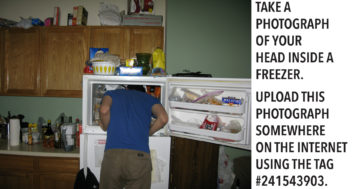
Originally published in the Marina Times in March 2019
The year was 1997. A French software engineer, Philippe Kahn, had become a father. Using a cobbled-together device consisting of his mobile phone, a digital camera and a linked online network, Kahn transmitted a grainy color photo of his newborn daughter Sophie. In the history of sharing photos, this was a groundbreaking development in sharing events in real time, a once unheard of possibility that has become an everyday occurrence in our contemporary era.
From March 30 through August 4, snap+share: transmitting photographs from mail art to social networks will take on the history of sharing photographs and the methodologies used to transmit them since the creation of the medium. Photography as shared art had its origins in the mail art movement, and this exhibit will feature early work by Ray Johnson, considered by many the father of mail art in the United States. Mail art usually involved sending a postcard, image or photographic equipment through the postal service often with text or instructions. Some of the recipients would be known to the artists, others were sent the work anonymously. The message in a bottle effect of disseminating artwork in this manner created a network of participants joined by the connectivity of this mail art web of imagery and narratives. Postcards by Joseph Beuys, Walker Evans and On Kawara will be shown in two galleries dedicated to the movement alongside more recent examples by Thomas Bachler and Moyra Davey.
“On Kawara’s work is a perfect example of the connection between mail art and social media,” said Clement Cheroux, senior curator of photography at SFMOMA. “By sending postcards in the 1970’s with the messages, ‘I got up at 8:15’ or “I got up at 8:22 a.m.,’ he is asserting ‘I’m here, I exist, I’m a real person.’ And this is essentially what we are doing today with Snapchat and Instagram.”
Human nature shows us that, when utilizing tools and new inventions, what starts as novelty quickly becomes perceived as necessity. As a young girl I visited a woman in a retirement village who was one of the first people in the United States to own a telephone. I was curious to know what she did with her telephone, since most people didn’t have them. Who could she call? She let me know that obviously she couldn’t call very many people during the first years she owned the phone. Instead, it sat on a table in the middle of the living room; visitors would sit with her, staring at the phone object, talking about all of the things that would happen in the world once this device became widely utilized. So it was a conversation piece, a kind of sculpture pointing toward society’s future direction.
In 2019, the telephone, which has been largely replaced by the cell phone, is a primary vehicle for making and sharing photographic art. Contemporary projects on view include videos and installations in which artists consider how we share images in the digital age. Erik Kessels’s 24HRS in Photos (2011) makes today’s mass transmission of images occupy a physical space in an immersive installation where every photo uploaded to the internet in a 24-hour period is printed out and placed-more like piled-in a single gallery. Jeff Guess’s video projection Addressability (2011) hypnotically depicts the dematerialization of photographs as physical objects but rather shared as digitized pixels. Corrine Vionnet shows the irresistible pull and uniformity of tourist photography -landmarks in Beijing, Paris, San Francisco and other cities in her series Photo Opportunities (2005-14). The exhibit continues outside the museum with Aram Bartholl’s enormous Google Maps’ red geo pin sculpture installed on top of the SFMOMA, acting as a parallel between physical and digital worlds.
snap+share will devote space to playful works involving internet memes like David Horovitz’s 241543903 (2009-ongoing) in which he encourages people to put their heads in a freezer, snap a picture and upload it using the tag #241543903, virtually linking thousands of people through a shared act. The show concludes with Eva and Franco Mattes’s Ceiling Cat (2016), a three-dimensional sculpture of the viral feline meme peering down at visitors from above.